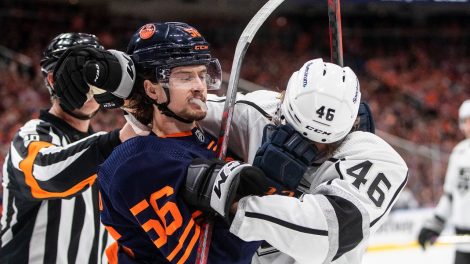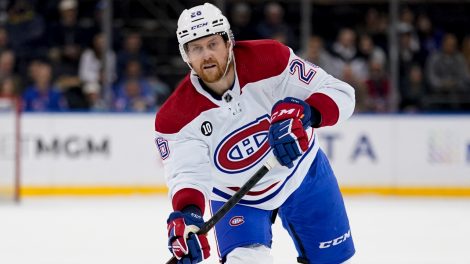Let’s be upfront and clear: Executing a successful NHL offer sheet is about as common as spotting Bigfoot riding Halley’s Comet to the lost city of Atlantis.
We haven’t seen one signed since Calgary dangled $10 million over two years in attempt to lure Ryan O’Reilly away from Colorado. The Avalanche matched, as nine of the past 10 offer-sheeted clubs have.
In fact, only one offer sheet in the past 22 years was accepted: Dustin Penner moved from Anaheim to Edmonton in the summer of 2007 for $21.5 million, and Brian Burke famously challenged Kevin Lowe to a barn duel in the process.
With that in mind, 2019 is totally the summer of the offer sheet strikes back, right?
“I look around the league right now and for whatever reason it seems like the Toronto Maple Leafs are the only team that’s going to be the target of an offer sheet. It seems interesting to me, but there’s about a third of the teams in the league that have a very highly talented [pending] restricted free agent — and some of them have more than one, as we do,” GM Kyle Dubas said.
“Our salary cap situation is set up that we could defend any of those threats with no worry at all. I know that they’ve become a huge topic of late, but I spend zero per cent of my time having any worry about that.”
Also Dubas: It’s “imperative” that the club extend Mitch Marner situation prior to July 1, when his 22-year-old leading scorer becomes eligible to ink an offer sheet.
Before we dig into the clubs that could hover over this summer’s stud crop of restricted free agents if they remain unsigned past June 30, let’s look at the updated cost of filing an offer sheet.
Offer sheet compensation for 2019 off-season
(based on AAV of sheet signed)
$0 to $1,395,053: None
$1,395,054 to $2,113,716: One third-round pick
$2,113,717 to $4,227,437: One second-round pick
$4,227,438 to $6,341,152: One first-round pick, one third-round pick
$6,341,153 to $8,454,871: One first-round pick, one second-round pick, one third-round pick
$8,454,872-$10,568,589: Two first-round picks, one second-round pick, one third-round pick
$10,568,590 and up: Four first-round picks
The prickly regulations around the offer sheet force such a near-magical set of circumstances to be met that, even with this June’s enticing RFA class, only a handful of talent-hungry clubs would meet the requirements.
GM Jeff Gorton, for example, has spent two seasons clearing the financial deck so his New York Rangers can make a splash this summer, but because he’s traded away his own second-rounder in the upcoming draft, he cannot offer-sheet anyone in the $6.34 million to $10.57 million range and is more likely to focus his efforts on unrestricted free agents.
The Sabres, Avalanche, Blue Jackets, Stars, Capitals, Penguins and Sharks all find themselves in a similar boat.
Because offer-sheet compensation rules do permit multiple same-round picks (i.e., four firsts) to be pushed a year to the future, all 31 teams are eligible for the monster offer sheet of a $10,568,590 AAV for up to seven years.
If we’re being generous, candidates for such riches include Tampa’s Brayden Point, Carolina’s Sebastian Aho, Toronto’s Mitch Marner, Colorado’s Mikko Rantanen, Boston’s Charlie McAvoy, Columbus’s Zach Werenski, and Winnipeg’s Patrik Laine and Kyle Connor.
But it’s arguable that none of those emerging superstars are worth more than Patrick Kane money, let alone $10.5 million plus four first-rounders — a pretty prohibitive price tag.
Which is why a lower-tier offer sheet targeting a cap-crunched opponent, like Toronto’s Kasperi Kapanen and/or Andreas Johnsson, Winnipeg’s Andrew Copp, Calgary’s Sam Bennett, Washington’s Jakub Vrana, or San Jose’s Kevin Labanc is more realistic. Who wouldn’t spend a second-rounder to pry a useful NHLer on the rise?
Another major hurdle is having enough cap space — and an owner willing to weaponize it — to make an offer so lucrative that the rights-holding club would be unwilling to match. (Because, let’s be honest, if you’re going through the effort of offer-sheeting a young star, you must believe it has a decent chance of going unmatched. Otherwise, you’re just ticking off an opponent for kicks, and thus inviting the wrath of the hockey gods).
The aforementioned teams (Toronto, Winnipeg, Tampa, Calgary, etc.) may wish to add, say, Aho to their dream-world roster, but they need to worry about getting their own RFAs under contract, so remove them from the mix of threats.
Eliminate Ottawa, too, because the rebuilding, budget-conscious Senators can’t afford to spend draft picks and aren’t willing to spend to the cap in 2019-20 anyway.
Then there is another cluster of teams — St. Louis, Washington, Pittsburgh, Vegas, Nashville, Anaheim, Minnesota — who find themselves in cap hell and need to relieve before they consider adding.
Never forget: The player has to sign the thing and be a willing participant in an offer sheet. Toronto-born Marner professes his Leafs love at every turn. Do you really believe Point wants out of (tax-free!) Tampa? Or Rantanen is tired of skating on Nathan MacKinnon’s wing?
The process of elimination chops the field significantly and leaves us with but a handful of clubs even capable of unleashing the unicorn.
Although the safe bet remains no one floats an offer sheet, here are seven candidates who meet the requirements and desire to at least consider one:
[relatedlinks]
 New York Islanders
New York Islanders
An Islanders’ offer sheet for Marner would represent the ultimate I-know-what-you-did-last-summer payback. So many free agents are coming off the books (Anders Lee, Brock Nelson, Robin Lehner, Jordan Eberle) that Lou Lamoriello has the cap flexibility to get creative. Also: the man is ruthless.
 Detroit Red Wings
Detroit Red Wings
Steve Yzerman’s Red Wings are a team in obvious transition, and one that could flip from rebuilder to contender faster than you think. Former GM Ken Holland did a fine job arming the Wings with picks (five seconds in 2019 and 2020) before joining the Oilers, and overpaid UFAs Thomas Vanek and Niklas Kronwall are coming off the books. Yzerman has always put business first (see: Drouin, Jonathan). How quickly and aggressively does he want to put his stamp on this team and supply Dylan Larkin with a complementary offensive stud?
 Montreal Canadiens
Montreal Canadiens
Marc Bergevin is at serious risk of letting the final great years of Shea Weber and Carey Price go to waste, bottom line. He needs a game-breaker up front. Drouin has failed to wow, and it would be unfair to bank on another 72-point performance from Max Domi. The prospect pool is rich; talent is coming. But because top-tier UFAs are tough gets in Montreal (John Tavares, remember, wouldn’t take a meeting last June), the offer sheet must be considered.
“When you sit in this chair, you’ve got to think long-term also,” Bergevin said at his end-of-season presser, noting the steep price tag of four firsts. “Trust me, it’s a tool that we look at all the time.”
 New Jersey Devils
New Jersey Devils
Ray Shero curiously didn’t spend a penny in free agency last summer, which didn’t sit well with some high-end players looking for a return to the post-season. Now he has another lottery victory and $47.4 million in projected cap flexibility. Shero’s top priority will be keeping Taylor Hall in the fold long-term (as a 2020 UFA, Hall is eligible to re-sign on July 1), and RFAs Pavel Zacha and Will Butcher need raises, but there is still room to make a splash.
 Carolina Hurricanes
Carolina Hurricanes
Two words: Tom Dundon. The new owner is aggressive and a wild card, the greatest outlier of the old boys’ network. Yes, the Hurricanes must ink a franchise centre like Aho long-term. But the increased revenue from this spring’s deep playoff run, which has already spurred a significant bump in season-ticket sales and sponsorship interest for 2019-20, could prompt a traditional budget team to loosen the purse strings and pitch an offensive star.
 Arizona Coyotes
Arizona Coyotes
Surely, John Chayka has seen the Hurricanes’ run and appreciated what on-ice success can do for attendance in a non-traditional market. The Coyotes were in the hunt until the regular season’s final week and are eager to end the longest playoff drought in the West (seven seasons and counting). They desperately need scoring and star power. The Phil Kessel trade rumours have already begun, but The Thrill will be 32 come puck drop and the elite RFAs line up better with the Coyotes’ growth.
 Buffalo Sabres
Buffalo Sabres
While the Sabres, as mentioned, don’t have the requisite picks to file an offer sheet between $4.23 million and $10.57 million, they could go for the big one, if they opt not to bring back UFA Jeff Skinner. Franchise centre Jack Eichel needs an elite wingman, and GM Jason Botterill is under pressure to end what has now become the longest playoff drought in the league (eight seasons). The locals are antsy in Buffalo, the coach has already been fired, and the Pegulas have never been shy to throw money at a problem. Toss in the fact that overpriced veterans Jason Pominville and Matt Moulson are coming off the books, and Botterill has some leeway to make moves.
Information via the invaluable CapFriendly.com and Sportrac.com.









